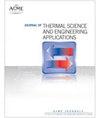Multiobjective optimization of air-cooled perforated micro pin fin heat sink via an artificial neural network surrogate model coupled with NSGA-II
IF 1.4
4区 工程技术
Q3 ENGINEERING, MECHANICAL
引用次数: 0
Abstract
Abstract This research aims to create an artificial neural network (ANN) regression model for predicting the performance parameters of the perforated micro-pin fin (MPF) heat sinks for various geometric parameters and inflow conditions. A three-dimensional computational fluid dynamics (CFD) simulation system is developed to generate dataset samples under different operational conditions, which are specified using Latin hypercube sampling (LHS). An ANN model is first obtained by optimizing the model hyper-parameters, which are then deployed to learn from the input feature space that consists of perforation diameter, perforation location, and inflow velocity. For accurate training of the ANN, the model is trained over a range of uniformly distributed data points in the input feature space. The developed multi-layer model predicted Nusselt number and friction factor with the mean absolute percentage error of 4.45% and 1.80%, respectively. Subsequently, the developed surrogate model is used in the optimization study to demonstrate the application of the surrogate model. A multi-objective non-dominated sorting genetic algorithm (NSGA-II) is used to perform the optimization of the perforation location, diameter, and inflow conditions. Negative of the Nusselt number and friction factor are chosen as objectives to minimize. A Pareto front is obtained from the optimization study that shows a set of optimal solutions. Thermal performance of the perforated MPF is increased between 11.5% and 39.77%. The optimizer selected a significantly smaller hole diameter at a higher location and a faster speed to maximize the Nusselt number and minimize the friction factor.基于NSGA-II的人工神经网络代理模型的风冷多孔微针翅散热器多目标优化
摘要本研究旨在建立一个人工神经网络(ANN)回归模型,用于预测不同几何参数和入流条件下穿孔微针翅(MPF)散热器的性能参数。建立了一个三维计算流体动力学(CFD)仿真系统,以生成不同操作条件下的数据集样本,并使用拉丁超立方体采样(LHS)来指定样本。首先通过优化模型超参数获得人工神经网络模型,然后利用模型超参数从由射孔直径、射孔位置和流入速度组成的输入特征空间中学习。为了准确训练人工神经网络,在输入特征空间中均匀分布的数据点范围内训练模型。所建立的多层模型预测Nusselt数和摩擦系数的平均绝对百分比误差分别为4.45%和1.80%。随后,将开发的代理模型应用于优化研究,以验证代理模型的应用。采用多目标非支配排序遗传算法(NSGA-II)对射孔位置、直径和流入条件进行优化。选择负的努塞尔数和摩擦系数作为最小化的目标。通过优化研究,得到了一个帕累托前沿,并给出了一组最优解。多孔多孔材料的热性能提高了11.5% ~ 39.77%。优化器在更高的位置选择了更小的孔径和更快的速度,以最大化Nusselt数并最小化摩擦系数。
本文章由计算机程序翻译,如有差异,请以英文原文为准。
求助全文
约1分钟内获得全文
求助全文
来源期刊

Journal of Thermal Science and Engineering Applications
THERMODYNAMICSENGINEERING, MECHANICAL -ENGINEERING, MECHANICAL
CiteScore
3.60
自引率
9.50%
发文量
120
期刊介绍:
Applications in: Aerospace systems; Gas turbines; Biotechnology; Defense systems; Electronic and photonic equipment; Energy systems; Manufacturing; Refrigeration and air conditioning; Homeland security systems; Micro- and nanoscale devices; Petrochemical processing; Medical systems; Energy efficiency; Sustainability; Solar systems; Combustion systems
 求助内容:
求助内容: 应助结果提醒方式:
应助结果提醒方式:


